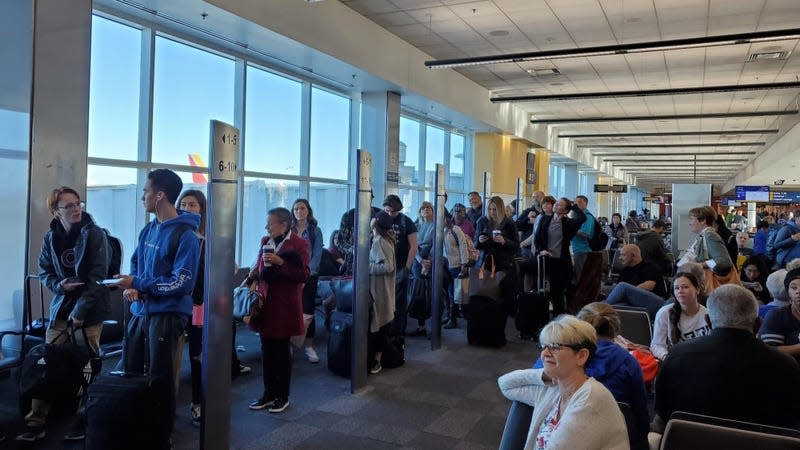There's A Faster Way To Board A Plane, But Airlines Won't Use It

When he’s not studying the behavior of planets thousands of lightyears away, the existence of dark matter, or its gravitational pull, astrophysicist Jason Steffen spends his hours studying human nature and the airplane boarding process. I guess when you can comprehend the deepest secrets of space, it’s nice to have a hobby that is a bit more [ahem] grounded. Steffen has seemingly uncovered the most efficient way of boarding a plane, and airlines are simply incapable of implementing it. Because humans don’t work the way they’re supposed to.
Airlines are always looking for ways to reduce costs, speed up processes, and pack more people onto planes to save a buck or make a few extra. The science behind plane boarding procedures at the gate have been studied and debated for decades, and even now it’s hardly settled. The process of getting a plane to the gate, de-boarded, fueled, re-supplied, cleaned, and full of passengers again is a more intricate dance than a Formula 1 pit stop, and shaving even a few minutes from the process can save an airline millions of dollars.
Read more
Marvel's Kevin Feige Teases When to Expect the X-Men In the MCU
That's The End Of Activision Blizzard's $120 Million Overwatch League
Starfield's Controversial Missing PC Feature Arrives In New Update
Our Picks For Link, Ganon, And More In The Live-Action Zelda Movie
The idea behind spacing out passengers in alternating rows is to reduce the probability of traffic jams. If the primary bottleneck of the boarding process is people waiting in the aisle, mostly because of how long it takes for others to load their luggage, Steffen’s fix maximizes the number of passengers stuffing their bags into overhead bins simultaneously. It takes a serial process (one at a time) and makes it parallel (several at a time).
This method works great in a lab, where the line of people waiting to board are able bodied paid actors. In the real world there are families with young children, and passengers who require additional assistance. There are people who arrive late to the gate, there are people who jump in line early, and there are couples who want to board together. Humans are a mess. Boarding flights would be a whole lot easier without them.
United, as it happens, did some real world A-B testing of WILMA and Steffen models to determine which was faster. In its testing United said WILMA performed better than Steffen’s theoretical model. It’s probably a bit of six in one hand and half a dozen in the other, really. Both methods employ basically the same human herding strategy by getting people to spread out as quickly and efficiently as possible. If you’re able to get to your row and get your bag stowed without standing in someone’s way, that’s an efficiency that works in the airline’s favor. But is there a better way?
The number one real-world proven method of getting people onboard an airplane is Southwest’s swarm method. By lining up groups of a couple dozen humans and telling them to find their ideal seat as quickly as possible, no seat assignments, the problem sorts itself out. Humans will always follow the path of least resistance. They’ll go to a spot that isn’t already occupied, they’ll find an overhead bin that isn’t filled, and they’ll typically grab a window seat first.
Southwest was in dire straits back in 1971 when the company very nearly went bankrupt. Then-VP of Ground Operations, Bill Franklin, came up with the solution to the company’s woes. At the time it was running just a few small regional jets, and Franklin developed the company’s famed “10-minute turn”, getting a flight in, re-fueled, and packed with new people, then back into the air in just ten minutes. High frequency and quick turns were the name of the game, so Southwest had to develop the most efficient way of getting people onboard.
Steffen agrees that Southwest’s swarm method is more efficient than WILMA. And Southwest isn’t content to just sit on its functional boarding system, as the company is continuing to develop new—admittedly somewhat dystopian—methods of speeding up the process even further. The carrier is currently experimenting with getting people off the plane faster by using both the front and rear exits of the aircraft, and speeding up the boarding process with flashing lights and music to add a sense of urgency.
It’s a simple problem with several not-so-simple solutions. One thing is for sure, airlines are well known for sacrificing passenger comfort to squeeze a few extra bucks out of the process. It’s unlikely we’ll ever see a return to 10-minute turns, and other airlines probably aren’t going to adopt Southwest’s [or Steffen’s] method any time soon.
More from Jalopnik
Sign up for Jalopnik's Newsletter. For the latest news, Facebook, Twitter and Instagram.

 Yahoo Autos
Yahoo Autos 